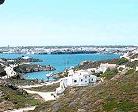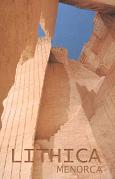The name Menorca comes
from "menor"which means littler, and the Romans gave this charming island
this name because Menorca is smaller than neighbouring Mallorca.
The island has 8 towns, the largest being its capital, Mahon.
The population of Menorca is 80,000, although this can increase dramatically in high season. Menorca has a survace area of 694.39 km². The official languages are Spanish and Menorquín, the local dialect of Catalan. Some adaptations of English words - such as "grevy" (gravy) or "bótil" (bottle) are widely used as a result of the years during which Menorca was under British rule.
History of Menorca
Like Mallorca, the first period to leave its important mark on Menorca was the Bronze Age, during the so-called "talayótic" period. Later Menorca was occupied by Phoenicians, Greeks, Megalithic, Roman, Vandal, Byzantine and the Moors. The Island was liberated (rather brutally it must be said) from the Moors by Alfonso III on 17th January 1287, and even today the 17th of January is Menorca's local fiesta day.
A few years after the reconquista, it became part of the "Kingdom of Mallorca" under Jaime II until Pedro el Ceremonioso gained control of the Island from the successor of the previous King, Jaime III. This was the beginning of the most unremarkable and untidy period in Menorca's history, as many fled the island, weary of the constant fighting between the aristocracy and the locals.
In 1708 Menorca fell under British rule, and remained so, except for a brief time under French rule, until the beginning of the 19th century when it was recovered by the Spanish army. The years of British occupation left their mark, not only on the menorquín dialect, but also on local customs and arquitecture.
Mahón, capital of Menorca
Mahón has been the  dministrative capital city of
Menorca ever since the island fell under British occupation in the 18th century.
The main natural feature of this city - and the principal reason why it proved
so attractive to foreign armies - is its incredible natural harbour, sheltered
from the fierce storms which sometimes blow over Minorca. It is considered to
be the best natural harbour in the Mediterranean and one of the best in the World.
dministrative capital city of
Menorca ever since the island fell under British occupation in the 18th century.
The main natural feature of this city - and the principal reason why it proved
so attractive to foreign armies - is its incredible natural harbour, sheltered
from the fierce storms which sometimes blow over Minorca. It is considered to
be the best natural harbour in the Mediterranean and one of the best in the World.
What to see in Mahón:
Hotels
in Menorca - click on link.
Until British occupation of the island, Ciutadella was
the capital city of Menorca, and the historic significance of this city is evident
from its beautiful buildings in the old quarter of the city which has been declared
a National Historical-artistic Monument. The local fiestas of San Joan are famous
all over Spain, and some of Menorca's loveliest beaches are close by.
What to see in Ciutadella:
 The
Cathedral of Menorca: 14th century gothic cathedral which was built on the
site of a former mosque.
The
Cathedral of Menorca: 14th century gothic cathedral which was built on the
site of a former mosque.
Municipal Museum of Ciutadella des Bastió de sa Font - a 17th century building with an impressive collection of prehistoric objects.
The old quarter: Winding streets full of the city's Moor and Medieval history. Of special interest, La Plaza del Borne, Plaza de Alfonso III and Plaza de la Catedral.
Canteras de s'Hostal:
Amazing maze (see photo) used to stage theatrical performances and concerts.
Where else to go in Menorca
Beaches in Menorca.
Menorca's great attraction is its outstanding beaches and small sandy coves hidden from view. The following are considered to be the most beautiful:
Ciutadella: Arenal de Son Saura, Algaiarens, Cala del Pilar, La Vall, Cala
Morell, Cala Blanca, Cala Bosch.
Es Mercadal: Ferragut, Cala Tirant,
Cala Pregonda
(Cavalleria), Es Mercadal
Ferreries: Cala Mitjana
Es
Migjorn: Cala Trebaluger
| Travelling to Menorca? The following links may also be useful | |
|---|---|